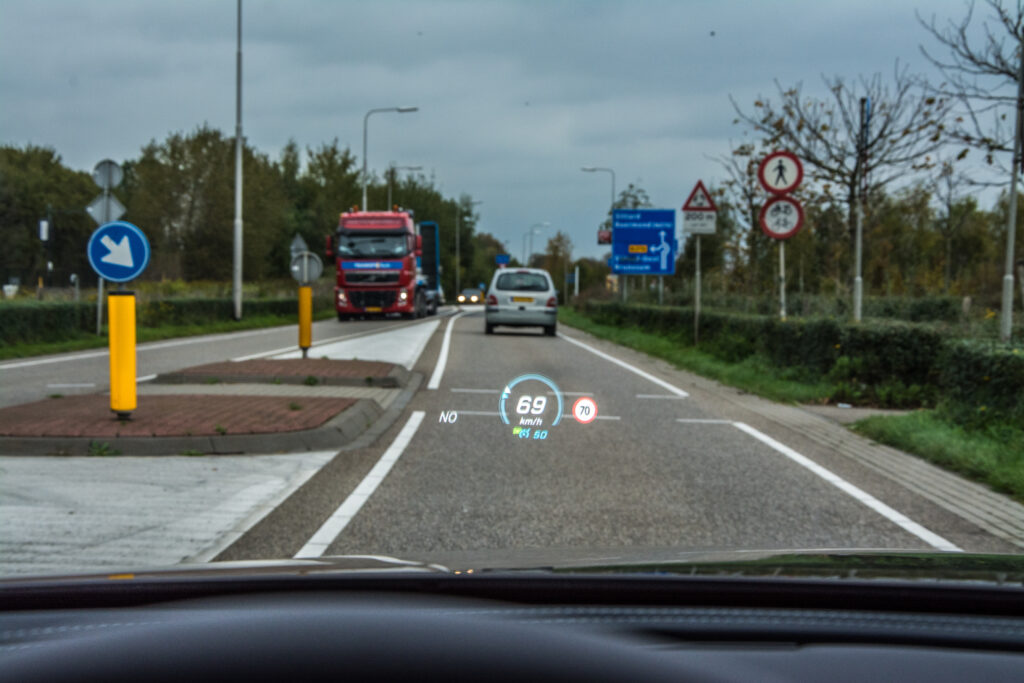A more integrated, triangular ‘driver-vehicle-infrastructure’ approach is needed to maximize the road safety benefits of ADAS – these are the findings from a recent research project, commissioned in 2020 by FIA Region 1, and developed by a consortium featuring Royal HaskoningDHV, TNO and HAN University of Applied Sciences.
The project provides valuable insights into the improvements required on each side of this triangle, and involved research carried out in relation to six selected ADAS – Autonomous Emergency Braking (AEB); Emergency Stop Signal (ESS); Intelligent Speed Assistance (ISA); Adaptive Cruise Control (ACC); Lane Keep Assist (LKA); and Drowsiness Detection & Distraction Recognition – with the findings translated into policy recommendations. The authors also noted that too often, the focus lies on the last mile of automation (SAE Level 5) – but perhaps more attention should be placed on the transition phase from fully manual to fully autonomous driving. A selection of the report’s most important findings is shared in the following paragraphs.
Semi-automation is a good thing,
semi-safety is not
While society waits for full automation to unfold, the automotive sector and legislators need to ensure that increasingly available semi-automation (SAE 1-3) technology sustains and contributes to road safety goals and visions, such as Vision Zero and Sustainable Safety.
In line with the Regulation (EU) 2019/2144, it won’t be long until all new models of cars are equipped with a variety of ADAS, with the main goal of assisting drivers to safely participate in the traffic environment. The extent to which the aimed level of safety can be provided, depends on numerous conditions that must be met to realize the full potential of this assistance to the driver. These relate to the technical optimization of ADAS’s functions, improvements to drivers’ knowledge, as well as infrastructure readiness to support the safe and comfortable functioning of ADAS.
The capabilities of each ADAS define the way and the extent to which a system can assist the driver in performing specific driving tasks. Next to the capabilities, system limitations and Operational Design Domain (ODD) are significant in determining their expected contribution to road safety. (The ODD defines the operating conditions under which a given driving automation system or feature thereof is specifically designed to function, including, but not limited to, environmental, geographical, and time-of-day restrictions, and/or the requisite presence or absence of certain traffic or roadway characteristics.)
However, too often, the desired insights into the limitations of the selected ADAS are not easy to find in the available user information. This lack of knowledge about the ODD means that neither car drivers nor the relevant authorities have a (complete) overview of ADAS capacities and limitations.
As a result, the systems in your car may fail to function because of ODD limitations or technical dysfunctions, which mostly originate from the limitations of their sensors. An adaptive cruise control (ACC) radar sensor may fail to detect preceding vehicles, an ISA camera can fail to read or misread traffic signs, while an AEB system can fail to detect small moving objects, such as pedestrians and cyclists.
Whereas these are examples of common problems, currently available systems hardly ever communicate these failures to the driver. The same applies in cases where the systems deactivate because operational criteria are not met, such as vehicle speed. As a result, drivers expect to be assisted when they are not. Their inability to react on time to a traffic situation because of false expectations of the systems can be the cause of road accidents. Combined with the drivers’ common overreliance on the systems, insufficient fail-safe communication can aggravate the consequences of a dangerous traffic situation.
The recent FIA-sponsored study concluded that even in cases where the systems fail to function well, potential road safety risks can be avoided by proper fail-safe communication. It is also found that although there are general design requirements based on reports from the European Commission, UNECE and the Dutch Safety Board, current system-specific requirements refer only to the fail-safe communication of ACC.
More driver training required
The FIA report sought to establish existing levels of user awareness through the reactions of almost 10,000 participants in an online survey, issued in six European countries, which gathered information on users’ knowledge, expectations and satisfaction of ADAS. It found that most ADAS users do not receive training on the systems. Instead, they rely on information from the car seller, the user manual or they apply the ‘trial-and-error’ method to familiarize themselves with ADAS. The quality of both information and instruction via these learning methods is far from perfect, which means that drivers receive incorrect and/or incomplete information and instruction.
The report also sought to discover if drivers’ trust in and satisfaction with ADAS is based on correct and adequate knowledge and understanding. According to its research findings, the answer is ‘no’. User satisfaction and trust was recorded as relatively high (between 3.5 and 4.5 on a five-point scale) for all studied systems.
Users were mostly satisfied with the ACC system, and least satisfied with the driver monitoring systems for distraction and drowsiness. Users also indicated that the ADAS performed as they expected, but they didn’t always know what to expect. The ADAS knowledge test, carried out among almost 10,000 drivers in Europe, discovered that most ADAS users have an incorrect perception and understanding of how and when the systems should function. Driver ‘over trust’ in these ADAS can lead to a potential road safety risk.
Respondents were – as expected because of lack of training – also unsure about situations when or where ADAS cannot function. However, they still felt confident enough to explain these systems to other people (especially in the case of ACC, LKA and AEB). Among the systems, ISA and ESS are better understood than ACC, AEB, LKA, and distraction and drowsiness detection.

Can I trust the car dealer?
Customers might need to think twice and ask some critical questions the next time before buying a new car. The study included a mystery shopping assignment that revealed there are remarkable differences in the type and level of knowledge of car sellers – not only among different car brands but also between individual sellers. Dealers seem to tailor the provided information to the type of customer, for example in relation to age or gender, or whether the customer buys a used vehicle, aside from their perceived feeling about the customers’ knowledge level and interests. The report found that too often, customers encounter a game of ‘no question-no information’, of which they should be aware if they wish to know about the automation options of their new car. It is therefore vital that sellers understand the importance of informing purchasers about ADAS in a clear and unambiguous way.
Annual vehicle checks
The report also suggests that ADAS should be included in annual vehicle checks for safety, roadworthiness, and exhaust emissions (as part of an MOT test, for example). For this to happen, the testing of ADAS functionalities must be achievable, measurable and verifiable.
Currently, there are a lot of unknowns and uncertainties: ADAS differ greatly among car manufacturers in terms of names, functionality, limitations, etc. (A fact reflected in the recent launch of ‘the ADAS Dictionary’ to counteract the proliferation of terms associated with ADAS.)
It also noted the functionality of ADAS could be quantified through onboard diagnostics (OBD), enabling the identification and diagnosis of correct operation and degradation. However, this is currently not possible because of the absence of data to diagnose them. For these reasons, a specific maintenance approach is required per ADAS per manufacturer. Moreover, calibration of the systems is becoming a big (extra) part of this maintenance.
In addition, considering that digital systems do not wear out like mechanical systems, it would be sensible to require continuous monitoring. However, this is not yet mandatory. Lifetime safety can therefore not be guaranteed.
Finally, the report also found that the increasing number of external connections, and the direct link between the computer systems and the control systems, due to ADAS, entails cybersecurity risks.
Lack of legal requirements or ADAS-ready infrastructure
The report also found that there are relatively few legal requirements, either national or international, for the design and safe use of ADAS. It is, therefore, not guaranteed that new ADAS are adequately tested for risks and will contribute to increasing road safety.
However, major efforts are being made to rate vehicles with ADAS in consumer testing (using Euro NCAP tests, for example). This has resulted in further development of such systems by car manufacturers since they are sensitive to Euro NCAP ratings.
Furthermore, the report found there are no specific regulations currently in force for cybersecurity, type approval and maintenance/lifetime security – however, recently developed UNECE requirements will be applied from 2022.
Regarding the last side of the ‘driver-vehicle-infrastructure’ triangle, the study found there are gaps in terms of the consistency of the environment in which ADAS operates. In particular, the lack of harmonised infrastructure in Europe, ranging from traffic signs to road markings, affects the operational efficiency of ADAS since the systems may be confronted with road conditions and traffic situations that fall outside of their ODD.
Key findings
While ADAS has the potential to deliver significant gains in terms of road safety, it is also undeniable that much remains to be done to turn the vision of safe semi-automated driving into reality. Therefore, governments, research institutes, OEMs, service providers, and road operators should align their efforts around an integrated ‘driver – vehicle – infrastructure’ approach and set clear goals for the short and the long term.
Being ready and successful in the safe use of semi-automation is a very necessary first step on the road toward fully autonomous driving. To reach the desired destination, the report concluded that further progress must be made on all levels:
- There is a lot of room for improvement in relation to the accuracy and reliability of ADAS. The report’s authors believe that there is an urgent need for international standards that clearly define what types of information, signals and messages should be communicated to the driver in case an ADAS fails to function. Vehicle user manuals should contain information for drivers about what to expect in case of a system’s failure.
- Good explanation to end users of the systems’ limitations and ODD is significant in determining the expected contribution of ADAS to road safety. Knowledge of ADAS and how to use them properly should become an integral part of driver licensing, and properly trained car dealership personnel should better instruct any new ADAS user to ensure safe use of ADAS. Voluntary seminars and life-long learning should be encouraged, and the driver’s role should be very clearly taught and tested both when driving with and without ADAS.
- Importance should also be given to accessible safety assessments of ADAS. In this way, the correct operation and degradation can be identified and diagnosed, and the driver can be notified in time of the malfunction. A clear standard must also be set for lifetime guarantee of ADAS (ideally applied during annual vehicle tests, such as an MOT). Also, the current directives for type approval admission requirements need to become stricter and receive frequent updates.
- All ADAS should have to comply with the same standards that state what the system is capable of and more importantly what it is not capable of (uniform functionalities). The design of a harmonized onboard diagnostic functionality for the repair and maintenance of ADAS requires uniform names for all systems. Therefore, vehicle manufacturers should be obliged to refer to systems using commonly agreed names.
Author details: Anastasia Tsapi & Peter Morsink, Royal HaskoningDHV; and Diogo Pinto, FIA Region 1- see the report in full, here.


